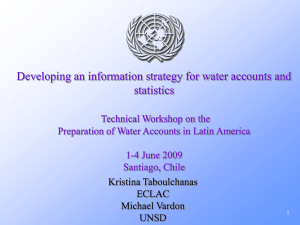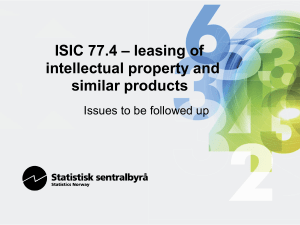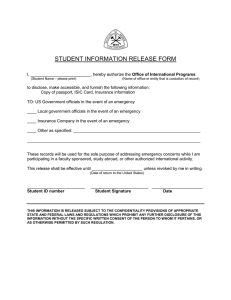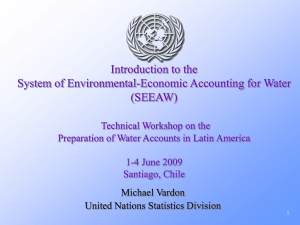System of Environmental- Economic Accounting for Water (SEEAW) Learning Centre on
advertisement
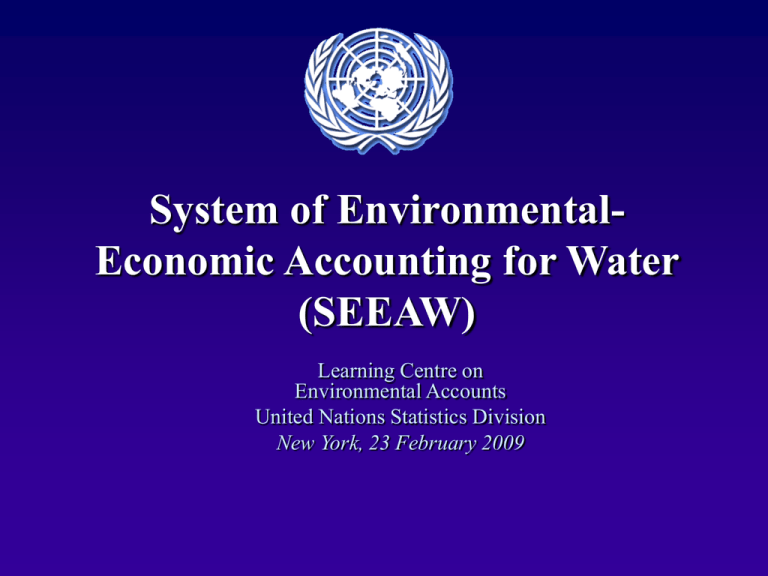
System of EnvironmentalEconomic Accounting for Water (SEEAW) Learning Centre on Environmental Accounts United Nations Statistics Division New York, 23 February 2009 Outline • • • • • • The need for SEEAW Background, process of development and implementation Main concepts and standard tables Common problems in compilation Indicator and uses Key lessons from implementation and the way forward The need for SEEAW • Supporting Integrated Water Resource Management (IWRM) • Understanding the links between the economy and the environment • Maximising/optimising the social, economic and environmental benefits of water use in the economy • Managing water scarcity and competing demands for water, especially in the context of climate change • Water as an economic good (e.g. water pricing, full cost recover, water rights) • Identifying water intensive and water polluting industries for policy response (e.g. application of users pays and polluter pays principles) • Bring together dispersed data into a multi purpose analytical framework SEEAW – an interim international statistical standard • SEEAW was adopted by the United Nations Statistical Commission in March 2007 as an interim statistical standard • SEEAW has been recognized as useful by the users of information “SEEAW provides the much-needed conceptual framework for monitoring and assessment” Roberto Lenton, Global Water Partnership • UNSD has developed an implementation plan and there has been rapid adoption by countries 44 Countries have, or are planning, water accounts* • • • • • • • • • • • • • • • • Andorra Australia Austria Bahamas Botswana Canada China Colombia Denmark Dominican Republic Egypt France Germany Guatemala Hungary Iraq •Israel •Italy •Jordan •Mexico •Namibia •Netherlands •New Zealand •Peru •Philippines •Portugal •Singapore •South Africa •Spain •Sweden •Switzerland •Trinidad and Tobago •Ukraine •Armenia •Estonia •Greece •Lebanon •Mauritius •Norway •Occupied Palestinian Territory •Romania •Tunisia •Turkey •United Kingdom *Data from the Global Assessment of Water Statistics and Water Accounts http://unstats.un.org/unsd/statcom/doc09/B G-WaterAccounts.pdf Soil water (reservoirs, lakes, rivers, snow, ice and glaciers) Natural transfers (e.g. infiltration, seepage, etc.) Inflows downstream basins and aquifers outside the territory of reference Outflows Groundwater Sea Collection of precipitation Sea Evapotranspiration Abstraction Returns Sewerage Returns • Stocks and flows • Economy and environment • Monetary and physical Surface water upstream basins and aquifers outside the territory of reference Returns Overview Inland Water Resource System Abstraction SEEAW Evapotranspiration Precipitation Atmosphere Households Other Industries (incl. Agriculture) Rest of the World Economy Imports Water collection, treatment and supply Exports Economy Rest of the World Economy Key Australia – physical water supply and use, 2004-05 (GL) Wastewater Water Reuse water ? ? 38 Sewerage ISIC 37 ? 280 ? 7 ? 13 ? 6 Water Supply ISIC 36 ? 78 2 ? 5329 72 Agriculture ISIC 1 6582 577 ? 341 Mining* ISIC 5-9 529 ? 115 Manufacturing* ISIC 10-33 246 227 556 Electricity ISIC 35 60172 110 1874 Other ISIC 2,3,38,39, 45-99 862 59924 Households 232 385 ? 2045 Inland Water Resources The Sea 1232 * Note shown is the supply of distributed water and reuse water by mining and manufacturing, 25 GL in total. 0 11160 Key Wastewater Water Reuse water Australia – monetary water supply and use, 2004-05 (million AUD$) ? ? ? Sewerage ISIC 37 55 ? ? ? 97 ? 772 ? Water Supply ISIC 36 2357 ? ? ? 291 53 Agriculture ISIC 1 ? ? 252 232 Mining* ISIC 5-9 ? ? 91 Manufacturing* ISIC 10-33 ? ? 698 Electricity ISIC 35 ? ? 2147 Other ISIC 2,3,38,39, 45-99 ? ? Households ? ? ? ? ? Inland Water Resources The Sea ? * Note shown is the supply of distributed water and reuse water by mining and manufacturing, 25 GL in total. No monetary available for these. Australia 2004-05: monetary vs. physical use of distributed water (% of total use) Households All other Industries Electricity Water Supply Value of water Volume of water Manufacturing Mining Agriculture 0% 10% 20% 30% 40% 50% 60% 70% Percentage of mean annual rainfall 1998-99 to -2000-01 Water consumption Percentage change 2000-01 to 2004-05 -30% -20% -10% 0% 10% 20% 30% 40% Household Water supply Manufacturing Agriculture Percentage of mean annual rainfall 2002-03 to -2004-05 16000 14000 12000 10000 8000 6000 4000 2000 0 2000-01 Ho us eh ol d try th er ind us O up pl y W at er s El ec tri ci t y M an uf ac tu r in g 2004-05 M in ing Ag ri c ul tu re ML (1,000 m3) Water consumption 12 Standard Tables 1. 2. 3. 4. 5. 6. 7. 8. 9. Physical supply Physical use Gross and net emissions Emissions by ISIC 37 Hybrid (Monetary and Physical) supply Hybrid use Hybrid supply and use Hybrid water supply and sewerage for own use Government accounts for water related collective consumption services (Monetary) 10. National expenditure for waste management (Monetary) 11. Financial accounts for waste water management (Monetary) 12. Asset account (Physical) 12 Supplementary tables Physical water use: Standard Table I Physical units Industries (by ISIC categories) 1-3 U1 - Total abstraction (=a.1+a.2= b.1+b.2): a.1- Abstraction for own use a.2- Abstraction for distribution b.1- From water resources: From the environme nt Surface water Groundwater Soil water b.2- From other sources Collection of precipitation Abstraction from the sea Within the economy U2 - Use of water received from other economic units U=U1+U2 - Total use of water 533, 4143 35 36 37 38,3 9, 4599 Tot al Hou seh olds Res t of the wor ld Tot al Physical water supply: Standard Table II Physical units Industries (by ISIC categories) 1-3 Within the economy S1 - Supply of water to other economic units of which: Reused water Wastewater to sewerage S2 - Total returns (= d.1+d.2) d.1- To water resources To the environme nt Surface water Groundwater Soil water d.2- To other sources (e.g. Sea water) S - Total supply of water (= S1+S2) Consumption (U - S) 533, 4143 35 36 37 38,3 9, 4599 Tota l Hou seh olds Rest of the worl d Tota l Water emissions: Standard Table IV Physical units Industries (by ISIC categories) Pollutant Gross emissions (= a + b) a. Direct emissions to water (= a1 + a2 = b1 + b2) a1. Without treatment a2. After on-site treatment b1. To water resources b2. To the sea b. To Sewerage (ISIC 37) d. Reallocation of emission by ISIC 37 e. Net emissions (= a. + d.) 1-3 533, 4143 35 36 38, 39, 4599 Tota l Hou seh olds Rest of the wor ld Tota l Hybrid water use: Standard Table VI Physical and monetary units Intermediate consumption of industries (by ISIC categories) Actual final consumption 35 1-3 Total intermediate consumption and use (monetary units) of which: Natural water (CPC 1800) Sewerage services (CPC 941) Total value added (monetary units) Total use of water (physical units) U1 - Total Abstraction of which: a.1- Abstraction for own use U2 - Use of water received from other economic units 533, 4143 Tot al Households of which: Hydro 36 37 38, 39, 4599 Total industry Final cons umpt ion expe nditu res Socia l transf ers in kind from Gover nmen t and NPIS Hs Total Govern ment Capital formation Exp orts Tot al use s at pur cha ser’ s pric e Physical water assets: Standard Table XII physical units EA.131 Surface water EA.1311 Reservoirs Opening Stocks Increases in stocks Returns from the economy Precipitation Inflows from upstream territories from other resources in the territory Decreases in stocks Abstraction of which Sustainable use Evaporation/Actual evapotranspiration Outflows to downstream territories to the sea to other resources in the territory Other changes in volume Closing Stocks EA.1312 Lakes EA.1313 Rivers EA.1314 Snow, Ice and Glaciers EA.132 Groundwater EA.133 Soil water Total Some common problems in compilation of accounts • Classification of units to industry in the case of multiple activities, especially those engaged in the activities of water supply, sewerage and hydro-electricity generation • In most countries national accounts do not separate the water supply and sewerage industries • In many countries the units supplying water or sewerage services are operated by government and in some they are incorrectly classified to government administration • Spatial referencing – economic data refers to administrative boundaries while hydrological data refers to river basins • Recording of losses in distribution and the flows for use of water in hydro-electricity and water for cooling • Boundary between environment and the economy, especially artificial reservoirs Use and indicators from SEEAW Source of pressure on water resources: • Macro trends in total water use, emissions, water use by natural source and purpose, etc. ‘Decoupling’ economic growth and water use, pollution • Industry-level trends: indicators used for environmental-economic profiles • Technology and driving forces: water intensity/productivity and total (domestic) water requirements to meet final demand • International transport of water and pollution Botswana: water use and economic growth 1993-1998 1.3 0 Volum e of w ater 1.2 5 Per capita w ater use 1.2 0 GDP per m 3 w ater 1.15 1.10 1.0 5 1.0 0 0 .9 5 0 .9 0 19 9 3 / 9 4 19 9 4 / 9 5 19 9 5 / 9 6 19 9 6 / 9 7 19 9 7 / 9 8 19 9 8 / 9 9 Netherlands: water pollution and economic growth, 1999-2001 120 115 110 nutrients 105 metals 100 wastewater 95 GDP 90 85 80 1996 1997 1998 1999 2000 2001 Projecting future water demands Australia 2050 Key findings of the Global Assessment and lessons from countries implementing SEEAW 1. Build on existing knowledge and recognise that a range of different systems are already in place 2. Cooperation is essential 3. High level support is needed 4. An agency needs to take the lead 5. A phased approach is needed and pilot or experimental accounts are very useful 6. A lot of progress can be made quickly Build on existing knowledge and recognise that a range of different information systems are already in place • Many institutions already have information • Countries have developed information systems to meet their own data needs for management, including international obligations • These institutions need to understand that their data is valuable and that others could use it for their purposes Cooperation is essential • The majority of countries report cooperation with other agencies in the production of water accounts (68%)* • Despite this the lack of cooperation or data sharing was identified as an issue in 32% of countries for water accounts* • Data are usually dispersed in many agencies (e.g. agricultural agencies collect information on irrigation water, water ministries collect information to construct water balances, etc.)* • In many countries there are data gaps and in some countries there is duplication of statistical activity* Cooperation in needed • Within statistical offices • Between statistical offices, water departments, economic/planning departments and agricultural departments • With the water supply industry • With the scientific and research communities *Data from the Global Assessment of • Between users and producers of information Water Statistics and Water Accounts http://unstats.un.org/unsd/statcom/doc09/B G-WaterAccounts.pdf High level support is needed • The water accounts require a high degree of coordination within and between agencies, and so high level support helps to ensure that: • The proper legal and administrative processes are developed and used for the sharing and integration of data and that the duplication of activity is reduced between different agencies • Within agencies it paves the way for internal cooperation • There are no “turf wars” between or within agencies • Resources need to be devoted to the production of the accounts. An agency needs to take the lead It is usual for one agency to take the lead in the coordination and production of the accounts. • In the majority (53%) of case the agency is most often the NSO* • The lead agency does the preliminary work, including learning the details of the SEEAW and investigating the available data *Data from the Global Assessment of Water Statistics and Water Accounts http://unstats.un.org/unsd/statcom/doc09/B G-WaterAccounts.pdf A phased approach is needed and pilot or experimental accounts are very useful • Start with the accounts that address the issues of most importance to countries: • In water scarce countries it has been water supply and use and asset accounts. In industrialized countries it has been pollution and emission accounts. • Pilot accounts enable indicators and other policy uses to be demonstrated with data A lot of progress can be made quickly • Many countries already have much of the data needed to compile water accounts • For example, China, Mexico, Jordan and Dominican Republic were all able to produce preliminary accounts within 6 months • In addition it appears that UNSD/UNEP, OECD/Eurostat and the EEA already collect much of the data needed to produce some of the water accounts • As such for many countries and agencies is a matter of rearranging current data to match the format of the standard tables and to ensure they are consistent with the definitions and classifications of SEEAW • In this process data gaps and deficiencies may be identified and, if important enough, these can be addressed The main roles of NSOs* • Usually the source of the national accounts • Often collect water data for example on water abstraction, treatment and distribution , connection sewers, etc., through household and business surveys. • Bring together the various stakeholders and help to ensure the commitment to the development and implementation of a multipurpose integrated information system (i.e. the SEEAW) in countries, to meet the needs of a wide variety of users needs. Making better use of existing resources would help to address problems with data availability and data quality, which were the main impeding factors for the compilation of water statistics and accounts in countries. • Lead the development of a data collection strategy to improve and further develop the water statistics and accounts programme in countries. • Assist in the process of harmonizing definitions and classifications related to water and ensure their harmonization with those used in economic statistics. *From the Global Assessment of Water Statistics and Water Accounts http://unstats.un.org/unsd/statcom/doc09/BG- UNSD activity to support the implementation of the SEEAW (In accordance with the SEEAW Implementation Plan presented to the UNSC in 2008) • Conducting of regional workshops • Targeted country assistance • Development of International Recommendations for Water Statistics • Development of a knowledge-base to house practical material and countries experiences on the compilation of water statistics and accounts
